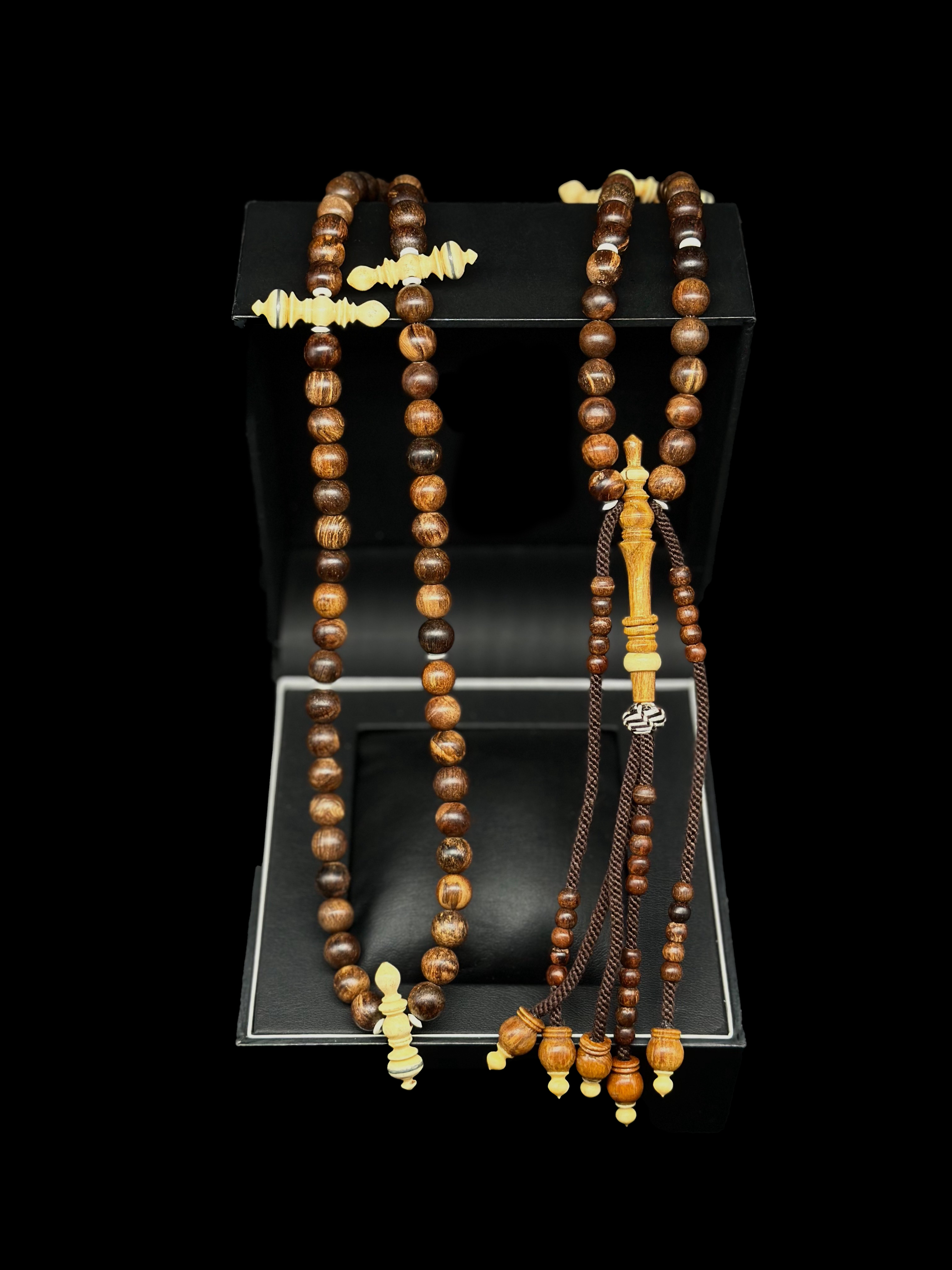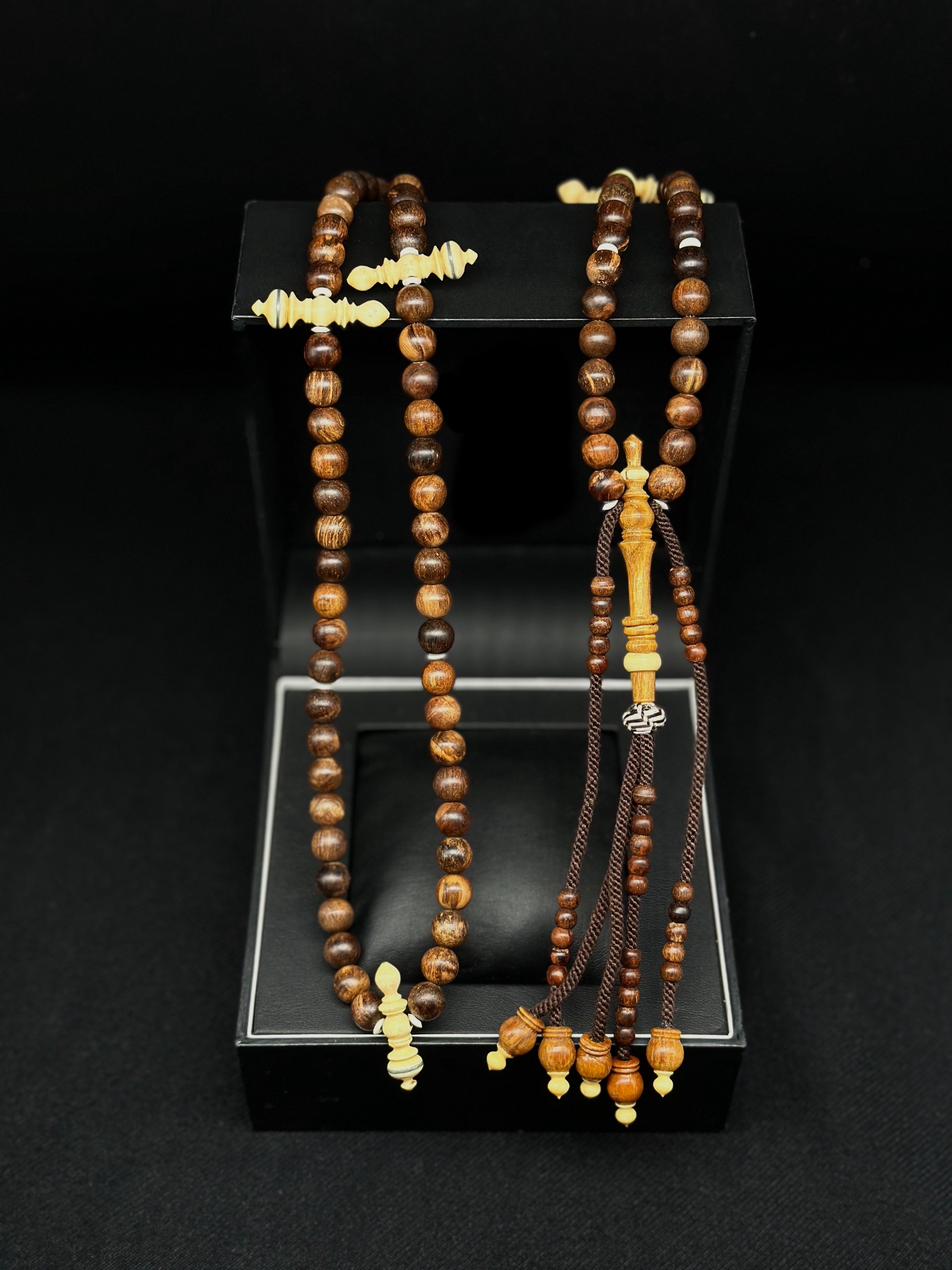

Oud Agarwood x Cow Bone Rumi Model Tasbih
The Material
Oud Agarwood, the most sought after material in the world.
Origin
“Use the Oud, for it cures seven diseases” (Sahih Al-Bukhari 5713).
Oud Agarwood, often referred to as "liquid gold" and known as Aloeswood in the Bible, is a sacred and treasured wood that has been used by Prophets from the Divine Scriptures, including Isa (Jesus) and the Seal of Prophets, Sayyidina Muhammad ﷺ. Its mention in ancient texts like The Vedas, one of the oldest scriptures in the world, traces its use back thousands of years.
History
Oud is also cited in The Chronicles of Japan, the second oldest historical record of Japan. This precious wood forms when the heartwood of Aquilaria trees becomes infected with a specific mold, triggering the tree to produce a rich, aromatic resin to protect itself. Prior to infection, the wood is pale, lightweight, and without scent, but as the resin—known as aloes—develops, it transforms into the deep, dark, and fragrant Oud. The aroma, often described as otherworldly or divine, can vary in intensity due to factors like environment and age of the tree.
In ancient times, Oud’s bark was also used to craft Sanchipat, a material on which people inscribed history, mythology, folk songs, medicinal knowledge, and Holy Scriptures, further cementing its place in the cultural and spiritual heritage of humanity.
The Craft
Stage 1 – The Design:
The intricate design of the prayer beads are envisioned by the craftsman and a rough outline is sketched out onto a blank canvas. It is at this stage where the craftsman selects which materials they wish to utilise.
Stage 2 – Acquisition of the raw materials:
The hunt for the chosen materials begins and the wood is then ethically sourced and harvested from the finest and 100% organic of materials.
Stage 3 – The resize:
Once the material has been sourced it is then cut into smaller blanks and is now ready to begin onto the next stage of the process.
Stage 4 – The carving:
At this stage the beads, minarets, and separator pieces are carved into the desired shape and pattern. It is important to know that this entire method is done by hand; there are no molds, markers or guidelines. This is a skill and art form which requires exquisite hand co-ordination and takes a craftsman many years to learn and perfect.
Stage 5 – Excavating the holes:
Similar to the last stage this is a skill which requires years of practise. There are no markers or guidelines, and if the holes are off by even a fraction of a millimetre the prayer beads will not be aligned correctly. If the holes are too narrow this will result in the beads being stiff and difficult to move along the thread. If the holes are too wide this will result in the beads being extremely loose and difficult to use.
Stage 6 – Unmasking the natural beauty:
The materials are then sanded to bring out the beauty which is hidden deep within the beads. slowly each and every grain is uncovered and is manifested within each bead.
Stage 7 – The set up:
There are currently 3 main set up systems of how prayer beads are separated;
Shadhili – 100 beads separated using 3 dividers in the set up of 33/17/17/33.
Naqshbandi – 200 beads separated using 7 dividers in the set up of 7/11/40/70
Tijani – 100 beads separated using 5 dividers in the set up of 12/18/20.
Stage 8 – The stringing:
The beads are now finally ready to be stringed together using a durable thread. It is at this stage where the thread tension is decided on and with some can even be adjusted afterwards.
Stage 9 – The tassel:
This process takes hours to complete and is crucial in the overall look and design of the prayer beads.
Stage 10 – The inspection:
The set of prayer beads are now ready for one last inspection before they are to be released.
Specification
Bead Count: 100
Bead Size: 8mm
Material: Oud Agarwood
Choose options



